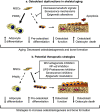Osteoblast dysfunctions in bone diseases: from cellular and molecular mechanisms to therapeutic strategies
- PMID: 25487608
- PMCID: PMC11113967
- DOI: 10.1007/s00018-014-1801-2
Osteoblast dysfunctions in bone diseases: from cellular and molecular mechanisms to therapeutic strategies
Abstract
Several metabolic, genetic and oncogenic bone diseases are characterized by defective or excessive bone formation. These abnormalities are caused by dysfunctions in the commitment, differentiation or survival of cells of the osteoblast lineage. During the recent years, significant advances have been made in our understanding of the cellular and molecular mechanisms underlying the osteoblast dysfunctions in osteoporosis, skeletal dysplasias and primary bone tumors. This led to suggest novel therapeutic approaches to correct these abnormalities such as the modulation of WNT signaling, the pharmacological modulation of proteasome-mediated protein degradation, the induction of osteoprogenitor cell differentiation, the repression of cancer cell proliferation and the manipulation of epigenetic mechanisms. This article reviews our current understanding of the major cellular and molecular mechanisms inducing osteoblastic cell abnormalities in age-related bone loss, genetic skeletal dysplasias and primary bone tumors, and discusses emerging therapeutic strategies to counteract the osteoblast abnormalities in these disorders of bone formation.
Figures


References
-
- Seeman E. Pathogenesis of bone fragility in women and men. Lancet. 2002;359:1841–1850. - PubMed
-
- Khosla S, Riggs BL. Pathophysiology of age-related bone loss and osteoporosis. Endocrinol Metab Clin N Am. 2005;34:1015–1030. - PubMed
-
- Riggs BL, Parfitt AM. Drugs used to treat osteoporosis: the critical need for a uniform nomenclature based on their action on bone remodeling. J Bone Miner Res. 2005;20:177–184. - PubMed
-
- Marie PJ, Kassem M. Osteoblasts in osteoporosis: past emerging and future anabolic targets. Eur J Endocrinol. 2011;165:1–10. - PubMed
Publication types
MeSH terms
LinkOut - more resources
Full Text Sources
Other Literature Sources
Medical

